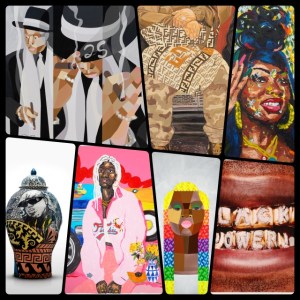By Aria Brent,
AFRO Staff Writer
This year marks the 50th anniversary of hip-hop and celebrations have been happening all across the nation. Whether it be live performances, exhibits or parties, hip-hop is getting its rightful due in 2023.
More than just a genre of music, hip hop has thoroughly blended into the daily happenings of American life and cultures around the world.

Started in the Bronx, N.Y. in 1973, hip-hop has become an international phenomenon, influencing everything from fashion and food to college course offerings and legal arguments. Hip-hop is not only heard, but felt.
“It’s life. It’s a way of thought. It’s the way we communicate–it’s the way we dress,” said Kariz Marcel, an internationally-recognized, Baltimore-based music producer.
“To me, hip-hop is an ongoing lifestyle. Hip-hop is the root of a lot of my creative choices,” said Marcel, the certified “hip-hop head” who recently held a workshop at the Baltimore Museum of Art.

The event was part of the museum’s celebration of hip-hop’s 50th anniversary, and showed people how beats were made using turntables, cassette tapes and vinyl records when hip-hop was first getting started.
The style of beat making he displayed was first created by DJ Kool Herc, born Clive Campbell, who is considered the “Father of Hip-Hop.”
Herc was the first person to use turntables with two vinyl records to focus on the “breakdown” part of a crowd’s favorite songs– the part where people could really dance. He debuted his style of going back and forth between vinyl records to play popular dance breaks back-to-back at a party hosted by his sister, Cindy Campbell. The event was a back-to-school event that came about when Campbell decided to raise additional money for school clothes. Fifty years later, what the two Jamaican immigrants began in the Bronx has become so much more than an elongated dance break.

The AFRO was at the Baltimore Museum of Art when Herc attended the opening of “The Culture: Hip Hop and Contemporary Art in the 21st Century.”
During the event, which included a celebration of hip-hop complete with breakdancers, Herc explained that he always knew what he created would catch on with the public.
”We expected it to go far and it’s reached the NFL now,” he said, referencing the hip hop tribute that took place during the Super Bowl halftime show this year. “I knew where I wanted it to go.

Campbell spoke on her own expectations for hip-hop to go far. She also expressed that as the movement grew more popular, a certain level of security came along with it.
“I knew where it was going to go and that’s why I stayed with it. In a way, I protected it and guided it. There’s a timeline and when following the timeline–yes, I did expect hip-hop to reach this point,” said Cambell. “When other artists from different states started to get involved I said, ‘Wait a minute this thing is growing, it’s traveling’ and I expected it to be where it is.
Despite hip-hop being enjoyed across the world, it has a special place in the heart of the Black community. It was started in a Black neighborhood, by Black people, in an era that was all about Black liberation.

“It’s important that we don’t lose grip of why hip-hop exists culturally. Music is one thing, but culturally it was created as a peaceful genre to bring people together to celebrate,” Marcel told the AFRO, when explaining how vital it is that we continue to honor hip-hop. “It wasn’t really about jewels or how much money you’ve got and things like that. It was more of a revolution for Black people coming from ghettos. We were able to connect with something that brought us all together. I think the importance of keeping that story alive is knowing that hip-hop is used to heal.”
Just as everything does, hip-hop has evolved and matured.
Throughout the last 50 years hip-hop has managed to sew itself into modern American history and culture. Hip-hop has become a juggernaut and is far removed from its origins of block parties. Campbell recalled when it truly became a business for them, and another cultural icon– Harry Belafonte– gave them sound advice in the middle of negotiations for a movie deal.
“Harry said to me ‘Cindy, are you an attorney?’ I tell him ‘No Mr. Belafonte,’ he says, ‘well you need to go out and get one!’” said Campbell, fondly remembering the moment. “He gave us good advice so we weren’t just there doing day-to-day [business] as it came along,” stated Campbell.

Although hip-hop has been around for a half-century it seems that this is just the beginning. People have high hopes for hip-hop.
“I hope hip-hop continues to be treated like fine art. I hope we appreciate it more as a form of expression and not just as a way of getting money,” expressed Marcel. “I think it’d be great for hip-hop to be treated like a school of thought. I hope that there’s more awareness on the cultural and societal impact of hip-hop as opposed to the monetary gain.”
The Baltimore Museum of Art will host the exhibit “The Culture: Hip Hop and Contemporary Art in the 21st Century,” until July 16.
The museum has set up multiple days for the public to enjoy the exhibit and unique celebrations of hip-hop.

On May 18 DJ Fly Guy will host the Hip Hop Vinyl Lounge. The museum will also offer free admission for all on May 21.
A screening of Nia June’s video The Unveiling of God / a love letter to my forefathers will take place on May 25, followed by a discussion. Another free admission day will be held on June 18, followed by the Art After Hours event on June 30.
For more information, please visit artbma.org.
The post Baltimore Museum of Art celebrates 50th anniversary of hip-hop music appeared first on AFRO American Newspapers .











